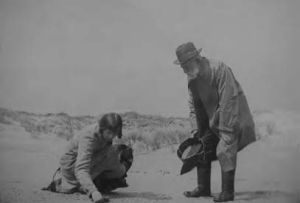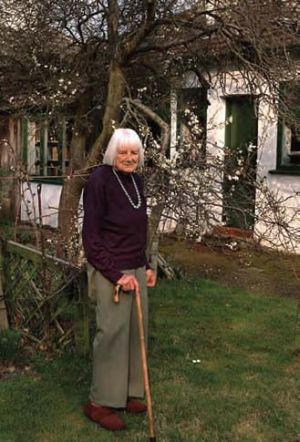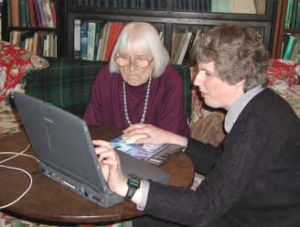|
Nora McMillan was a professional conchologist of international standing. Although based for most of her working life at the Liverpool Museum, she was born and brought up in Belfast. She was born Eleanor (‘Nora’) Fisher on 16 March 1908, the first of Ernest and Janet Fisher’s two daughters. Her father was managing director of the Lindsay Thompson flax-spinning mill, when Belfast was still one of the world’s leading producers of linen and rope. She was educated, with mixed results, by governesses and a couple of private schools, before being sent to board at Liverpool Girls’ College in Huyton. Typhoid fever as a teenager terminated her formal education. Her interest in shells was sparked by summer visits to the beach at Millisle from a very early age, where the first shell she recalls identifying was a purple Chlamys varia in 1914, at the age of 6. That shell is still part of the collection in Liverpool Museum. Her first shell book was Step’s ‘Shell Life’, and by the age of 6 she could identify 34 species of shell. Keen to encourage this interest, a family friend, H.C. Lawlor, introduced her to the photographer and naturalist Robert Welch, and to the Belfast Naturalists’ Field Club. Welch was a President of the Conchological Society (in 1923), and, to my knowledge, the last to be elected whilst living on the island of Ireland before my own election to the post. Throughout the 1920s, Nora’s growing expertise as a budding conchologist was nurtured by Welch and other prominent members of the Field Club such as Robert Lloyd Praeger, the geologist J. K. Charlesworth, and particularly Arthur Stelfox, who was a major influence. Nora Fisher and Robert Welch are pictured collecting marine molluscs together in 1930 (dredging in Strangford Lough); and collecting land shells on 1st May 1932 on a Conchological Society field trip at Portstewart (by Ranald MacDonald), in Estyn Evans and Brian Turner’s marvellous book Ireland’s Eye, which is a homage to Welch and his photographic legacy (Figure 1). She often stayed with Mr and Mrs Tomlin in England as a young woman during the 1920s and 1930s, enjoying a house crammed to overflowing with books, especially on Mollusca. Her first published paper was in 1926, in the Irish Naturalists’ Journal (1: 69-70) on ‘Piddocks (Pholas) at Greenisland, Belfast Lough’, with two further papers in the same journal in the same year ‘Living sea horse (Hippocampus) at Greenisland, Belfast Lough’ (1: 70) and ‘Helicella itala from County Down’ (1: 91). There were many papers, article, notes, and two books subsequently. In 1929, Nora was employed on a temporary basis for 15 shillings per week by Belfast City Museum & Art Gallery (later the Ulster Museum) to work on the natural history collections (then only recently transferred to the new building on Stranmillis Road). Four years later in 1933, she left Belfast to take up a permanent job at the Liverpool Museum (thanks to a personal recommendation made by Prof. Charlesworth to the Museum’s Director), looking after their shell collection and working in particular on their fossil shells. As was the custom in those days, when she married her landlady’s brother William McMillan, a dental surgeon, in 1937, she had to leave her post at the Museum. From c. 1938, she held two small part-time posts, one in the Dept. of Geology and one in the Dental School, both of Liverpool University until 1956. She returned to work in Liverpool Museum first full-time, and then in 1973, part-time for the rest of her long career, becoming a respected curator, researcher and author, but always keeping in touch with her Belfast roots. She travelled widely in Europe, to Lake Chad in Africa, Australia and New Zealand, and went on a lone shellcollecting expedition to a whaling station in the Arctic Ocean in c. 1972. A past President of the Conchological Society (1956 & 1957), in 1970 her contribution to science and her expertise was recognised by being elected to the Royal Irish Academy; in 1991 with a honorary master’s degree from Liverpool University; and in 1993 by being awarded the MBE. She retired from the Museum in 2000, although her expert knowledge continued to be in demand. Known as ‘Mrs Mac’ to most of her friends and colleagues, she spent most of her life in a house at Upland Road, Bromborough which backed onto part of Dibbinsdale Reserve, to which she was a ‘friend’ for more than 60 years, recording its flora and fauna. After her husband died in 1954, she spent nearly 50 years in this house – but having at least 10, 00 books as company with pet snails, goats, dogs and cats! An article in a local publication Cheshire Life in 1976 describes her pet snails as being a present from a friend who brought them back from Australia – Helix pomatia, which apparently re-emerged in her garden every April. Her garden was also described as being the home to a colony of Arion lusitanicus. Nora McMillan died in hospital on 23rd August 2003 after a short illness, aged 95. She will be mourned not only by those who knew her personally at home and at work (a recent issue of the National Museums of Liverpool’s staff magazine called her a ‘Liverpool Museum institution’), but also by a much wider circle of naturalists around the UK and beyond. By the time of her death, she had become almost the last direct link with two generations of Victorian conchologists who brought such distinction to Irish and British natural history through their personal research and field collecting - such men as Robert Welch (1859-1936), Robert Lloyd Praeger (1865-1953), J. R. le B. Tomlin (1864-1954) and Arthur Stelfox (1883- 1972). It was a pleasure and a privilege for both me and my colleague at the Ulster Museum, Dr Peter Crowther, to meet Nora at her home in Bromborough on 27th March 2003 (Figure 2), when we had the opportunity to talk to her about her long museum career as a conchologist and her formative years in Belfast. However, while she was patient enough with our questions about the past, to her great credit she was much more interested in the laptop-based database of Irish marine molluscs that I had brought to show her, and its future potential (Figure 3)! The conversation given below is accurately transcribed, but substantially edited and rearranged from a 90 minute tape that was made of the conversation between me, Peter Crowther and Nora herself. I have not indicated below which person asked which question. It is also primarily about her early days in Northern Ireland. Jan Light had planned to visit Nora to talk with her about her time at the Liverpool Museum, but sadly this did not happen. On one occasion when we were still living in Glendinnis, we left there when I was either 5 or 6... anyhow like all children do, I had a den .... outside my nursery window, ....and one day my mother was tidying up, and said What has this child been doing, and she investigated the den and here was a fine collection of bits of crockery which I’d washed and set out, you see, and the different patterns came from our house. Upon enquiries she was satisfied her child had opened the rubbish tip and collected pottery... So collecting was in the blood! What was [Robert] Welch really like?
Very sweet. He was one of those teachers of natural history who would go to endless trouble for anybody. I owe everything to him, because he knew who to ask and who to get in touch with, the most selfless man you could imagine. And you met him when you were four..?
Well I couldn’t say..., but I can remember very well how I met him. Father suddenly remembered [who] maybe able to help identify shells, I was struggling with shells. So he got in touch with a friend of his in the [Belfast Naturalists’] Field Club, H.C. Lawlor. He said....come to tea, and I remember that time... I can see Welch to this day bursting in ....Where is she, Lawlor, where is she? And did you join the Field Club as a junior member..?
Oh yes, I wasn’t allowed to get away with it. It was the days when it was an elegant occupation for a lady. Well it was. I was going to ask you how it was to be a woman with so many men. I mean in those days...
I didn’t mind. Was it more equal in that area, than in other spheres of life? Did women have more respect?
Yes, I think it was, I think so. I think the Field Club always stressed equality, not that it would have been called that at the time, because you can go right back to that famous photograph of 1868 5 years after the Club was founded), with the Field Club scattered across the Giant’s Causeway columns, and there’s as many women as there are men in that famous shot. Was Welch particularly encouraging of the younger, of the junior members?
Oh yes, very, very good and endlessly patient with them. Which school did you go to?
Various schools. Every time the family moved, I moved to a different school. So with all this moving around, you only got a basic education as in reading, writing ...the three ‘Rs’. Did you get taught any natural history at school?
Not a thing, it wasn’t done. So you are an entirely self-taught naturalist?
No, everyone taught me! By people like Welch?
Like Welch, yes. And a passion for books, anyhow... I think I would agree with you that the key to education is having a passion for books.....The actual field meetings [of the Belfast Naturalists’ Field Club], you went on those, I suppose?
Oh yes, I was urged to go.... Welch introduced me to Stelfox, who took me firmly in hand. So then Stelfox became an influence on you?
Oh, very much so. Do you remember how old you were when you were introduced to Stelfox?
Oh dear, I don’t remember, I’m sorry. I always kept a natural history diary, but never a real diary. I couldn’t be bothered. Life’s too short! [general laughter!] When you went on field trips...do you remember how the meetings were organised and the number of people that used to go on them, were they very well attended?
They were well attended and they usually ended up at tea, which was rather nice because you could swap records and things. We were [living] outside Belfast, but however I was fortunate in one way. Welch was always saying to me to go to London to the British Museum, you must ask to see Tomlin, so I said all right I’ll do that, so I did. I was having a holiday in London with some cousins and my uncle, he took me to the museum. I can’t think how old I was, in my teens .... There was this nice-looking old boy with a shock of white hair, good-looking old man, and I explained who I was and I said I was told to ask for Mr Tomlin, and I am Tomlin says he, and from that day on I was firmly taken in hand. We used to stay with him sometimes, it was quite an education. Every room in the house was bunged full of books. I think he must have had every word that was ever commissioned. When I was stuck for a book, I wrote to Tomlin, where do I get a copy of so-and-so and how will I pay for it. He wrote to me on one occasion, during the war, during the 1940s, and said that he was very pleased because he had just found a nice large dry cellar under his dining room that he hadn’t known about and it just holds his Encyclopedia Britannica.
So you had a long correspondence?
Oh yes, till he died. Did you get to meet [Robert Lloyd] Praeger [the premier Irish naturalist; published a list of shells from the northeast of Ireland] often in Belfast at all when you were there?
Oh yes, we used to go and stay with him now and again. He was a very nice man. He used to come and stay with my people sometimes, if there was something special to look at. I don’t think he ever drove a car in his life you see. He told Charlesworth that he did nearly all his fieldwork on bicycle. On one occasion I was walking and he took me up to look at some particular bog. I’m not very keen on bogs. Frankly I’m frightened of them... and [it was] a rather shaky one. Anyhow, he walked across, you see, so I followed, carefully followed, he put his foot there, I put my foot there too, then he turned around cold bloodedly and said Don’t you think your seven stone might go where my seventeen stone has? Another day we were exploring the Glens of Antrim, and it was a blazing hot day, terrible hot day.....teenager as I was in a cotton frock and sand shoes and that was about all, and the sun got hotter and hotter and [he] took off his jacket, and then pulled off his shirt, so just in his breeches – I think if I hadn’t been there, he would have had those off too! What did you used to wear when you used to go on the shore? Did you wear shorts or dress?
I think I usually wore a skirt. I remember, Ranald [Macdonald] and I ...twice we went to Lough Foyle, and I usually wore shorts. I just wore what I happened to be wearing. What did you use, did you take a bucket, did you have a bag or..?
I think it must have been an old accumulator jar. And you just picked things up? Did you collect weed, that sort of thing, or just turned rocks..?
I think we were just interested to turn over a nice big stone, and settle down and have a really good look at it.... I always liked sea slugs..... I had a friend, she’s dead now. She was a biologist at St. Andrew’s for many years and we were out collecting one day together - seaweed and shells go very nicely together. And she said Oh, that’s it! and I said What do you mean Helen? and she said For years and years I wondered why so-and-so and now I see. I said Don’t worry, there’ll always be that sort of thing. A piece just falls into place. And you were working on the existing collections [in Belfast], you weren’t going out and collecting new material for the museum?
Anything I did collect was for the museum, I’ve never had a private collection. So all your material went to whichever appropriate Museum, whether it be Belfast, Dublin or Liverpool? Yes. Did you come back often? I know you went over to Liverpool in 1933?
For a while I used to come [back] every 3rd or 4th weekend. I had an arrangement. I would work on at the Museum, and I would have 2 weekends [off] and I would go home on the Saturday. So I really would keep in touch for quite a long time like that. You came back specially [for work with Ranald Macdonald in Lough Foyle 1936- 39]?
Yes, it happened to coincide with Welch’s death [in 1936], a rather sad thing. When Welch died.... at the funeral, I met [William] Megaw [a local, well-known naturalist] who said I’m pleased to see you, and do you know, he said, I found a rare mollusc coming up here. Welch would have loved that. And you had so long at Liverpool as well. Yes, I completed my seventy years in museums at Liverpool. There was the Ulster Museum, then the Liverpool Museum, and then when I got married they threw me out of course, because you weren’t allowed to be married. Quite appalling. Have you been back to Liverpool Museum very recently, since they’ve had the refurbishment there?
That pleasure awaits me! I’d heard that everything is now back in the Museum after the refurbishment, but I haven’t seen it yet..
I went to see them in an awful tin shanty place. It was pretty dreadful, couldn’t get at anything, everything was packed up and I haven’t been back since....what has happened to my shells? You’ll have to go and check up.
I’d like that, you know. Do you want some tea? That’d be lovely Nora, we could take a good break.
I’ll put the kettle on........ |
Fig 1 Nora Fisher and Robert Welch pictured collecting marine molluscs together in 1930 (Photo Ranald MacDonald)
Fig 2 Nora McMillan (Photo Julia Nunn)
Fig 3 Nora McMillan and Julia Nunn (Photo P. Crowther) |
In conversation with Nora McMillan MBE (1908-2003)
Issue
11
Page
10



